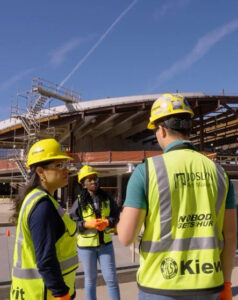Tips for Building an Effective Construction Foreman Training Program
 For the construction industry to meet the rigorous demands of today’s project schedules, it’s imperative to have a knowledgeable and efficient workforce.
For the construction industry to meet the rigorous demands of today’s project schedules, it’s imperative to have a knowledgeable and efficient workforce.
Standardized training programs for foremen help create consistent skills and processes that lead to more predictable project outcomes. Here are some tips that can help your company establish an effective training program for foremen and frontline supervisors.
Identify the Right People and Start Training Before Promoting
Many foremen are thrust into this important position with little notice. While this reality has been experienced by numerous foremen across the industry, it is likely not the ideal leadership development strategy for a construction company to follow. A different strategy is to identify potential candidates for foremen roles ahead of time, then incorporate them into a planned and facilitated leadership pathway prior to an official promotion.
This development pathway can include educational courses, seminars, mentorship and other ways to introduce these candidates to the things they may experience if they become a foreman. This process helps top talent ease into a new role, rather than to experience a sudden change with no runway for preparation.
Establishing a leadership pipeline with quality training can help companies create foremen who are well-prepared, confident and ready for their new responsibilities.
Use a Standardized Training Model
When developing a program, it is essential to include standardization in all facets of the education process, including mentoring, shadowing and classroom curriculum. It’s important that individuals receive consistent instruction, and a standardized training model will help meet this objective.
Standardized programs enhance efficiency and performance. Having one program eliminates the need to design unique programs to fit multiple individuals, and can be taught repeatedly by different instructors, saving time and resources.
Implementing a consistent program gives all employees the same level of access to resources and tools, and creates a consistent, more predictable outcome on the job site and across the industry.
Cover A Wide Scope of Responsibilities
On a job site, foremen are called upon to help resolve issues, analyze and process workflows, identify when project adjustments need to be made to improve efficiency, and direct and communicate with a crew to accomplish tasks in a timely manner.
The foreman usually oversees a crew of 8 to 12 workers and is responsible for safety, quality and productivity. Most foremen receive some training in supervision and safety, however, in a CII survey it was found that core competencies in communications, scheduling and quality control training dropped off considerably.
These areas of core competency are considered central to the success of a qualified foreman, yet they have been omitted or overlooked by many companies through the training they provide. By investing in comprehensive skill development that addresses these gaps, companies can ensure they’re preparing leaders who can effectively execute the full scope of their responsibilities.
Combine Coursework with Hands-On Practice
A key to a new foreman’s success is proper support from their company. The company can help foremen prepare for their new role by providing them with the tools and resources they’ll need to succeed.
The construction industry is very familiar with the apprenticeship model, where trainees learn via on-the-job and in a classroom setting. A foreman training program can also benefit from following a similar hybrid structure, where coursework is supported with hands-on practice and real-life opportunities.
For example, a future foreman’s training may include online or in-person educational courses about leadership and supervision, communication, work quality, productivity, and health and safety. Then, during or following each course, the foreman-in-training can shadow a current construction supervisor and assist them on specific tasks that relate to what they’ve learned, implementing the tips and insights they’ve gained in the course.
This structure helps prospective leaders learn useful strategies and concepts and gives them a low-pressure and safe environment to put them into use. By the time they are officially elevated to a leadership position, they already have valuable real-world experience.
Foreman Training Solutions from NCCER
Craft professionals are often called upon and promoted to foreman without the training they need, like communication, leadership and management skills.
As part of its ongoing effort to assist contracting companies and their workforce, NCCER’s Fundamentals of Crew Leadership curriculum and Construction Foreman Certification Program are both educational tools that can help craft professionals transition into a supervisory position.
Having a training program in place, with the assistance of NCCER, can shorten the learning curve to get your next leaders comfortable and confident in their new role. The standardized certification program offers five module courses that will deliver the skills necessary for foreman success.


